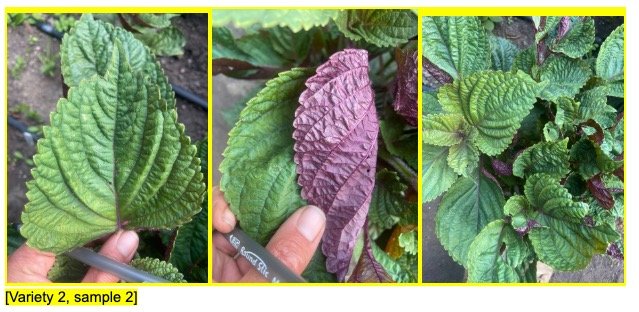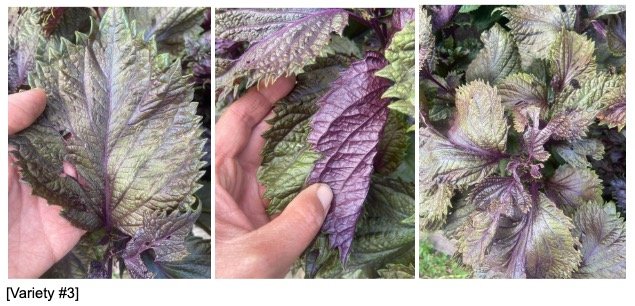Viet Perilla Variety Trials
Kellee Matsushita-Tseng
As we walk beside rows of sunflowers on the edge of the trial area, the shimmering green purple leaves of our Tiá Tô greet us. Though gophers have been a major struggle this year, and beginning with small populations of plants has made this season stressful, we are still excited to share Tiá Tô with community samples from our trials of several varieties of Tiá Tô with the community this year.
This perilla is distinctly different from kkaennip (Korean Perilla) or shiso (Japanese perilla). Some of the things that we are wanting to explore this year is what feels most distinctly important for Tiá Tô, what are the qualities that make it distinct and beloved for folks that love it. While Tiá Tô can be found readily at Vietnamese markets in urban centers, it is less readily available for folks outside of cities with large Vietnamese communities. Chef Amanda of Auntie Manna’s has described Tiá Tô as something “between mint and cilantro”, that is “vibrant and sometimes gives a citrus hint when eaten fresh'', with leaves that are smaller than most Korean or Japanese perilla types. Tiá Tô that is found in the Vietnamese market is typically purple on one side and green on the other side, with leaves that are tightly and uniformly serrated. The purple of these leaves is much darker and more vibrant than the subtle lavender undersides of the 38N Kkaennip that is offered by Second Generation Seeds, for instance.
In this trial of Tiá Tô, our goal is to see what the most important traits are to retain, keep clear, and steward, and to gather more information about the most important aspects of Vietnamese perilla. Within the Viet community locally, it seems as though Tiá Tô is often commonly accessed through either small home gardens with vegetables and herbs, or even from cuttings obtained from the market. This year we are trialing 4 varieties of Tiá Tô from seed to understand a little bit more about the taste, color, and varietal preferences of the Vietnamese community.
Side by side seedling differences
We have definitely seen some genetic variation seed batches from the same source, showing either difference in color (that amount of red/purple pigmentation), or the leaf/serration pattern, or the frilliness and overal leaf shape. We are growing Tiá Tô from a Vietnamese elder in the San Jose community, and some from three other small seed companies (Tomorrow Seeds, Caribbean Seeds, and True Love Seeds). With challenges in access to growing space and greenhouse space, our trials began later than ideal. Seedlings were planted into the ground on June 17, with a somewhat late start to a plant that flowers in response to photoperiod length.
Staging seedlings for planting in a semi-randomized fashion
Planting map-original
Planting map after replants in yellow, and gopher losses in red
Nonetheless, our plants have rapidly put on leaf sets over the past two months thanks to fertile and well prepared soil. We attempted to plant in a somewhat randomized pattern to get more accurate trial results, though gopher less has made it hard to assess the success of using a randomized pattern to balance variability in the field. Below are photos from the 4 varieties that we are growing this year, as well as additional photos showing some of the genetic variation expressed within a single variety (shown when there are two samples of the same variety below)
While Vietnamese communities in diaspora are of course existing with their creative resilience and resourcefulness to create the flavors of home wherever folks are, it’s definitely undeniable that the flavors and qualities of Tiá Tô are distinct and beloved, especially to some of the specific dishes that it is core to, such as bánh xèo (sizzling crepes), gỏi cuốn (spring roll), and noodle soups like Bún bò Huế.
These trials will culminate in two Viet-centered community events to share/taste perilla from our trials this year. The first will be a small intimate event, featuring chef Amanda of Auntie Manna’s, so that we can dig in to understand more about the taste variability of each of the four varieties we are trialing, and which qualities are most highlighted within the dishes that we will be offering. One of the dishes will be Bò Nướng Tía Tô (Grilled beef wrapped in perilla), as wrapping meat in the leaves will offer key insights on the flavor preferences. Collecting preference on color and leaf shape will also be part of this event, though taste will be centered as the trait that we explore and focus on.
The goal would be to walk away knowing which traits feel most important for the Viet community in Tiá Tô, knowing that not just one of our varieties may be the most preferred. We hope to learn more about how and where the Viet community accesses Tiá Tô, and how this information is shared within the community. In stewarding Tiá Tô seed, we really hope to be able to guide this as a process that is deeply anchored in community. We will also be hosting a virtual cook-a-long featuring Kknaennip and Tiá Tô, to learn more and share about the distinct qualities and traits of each of these beloved plants, and what makes them so special.
-Kellee











